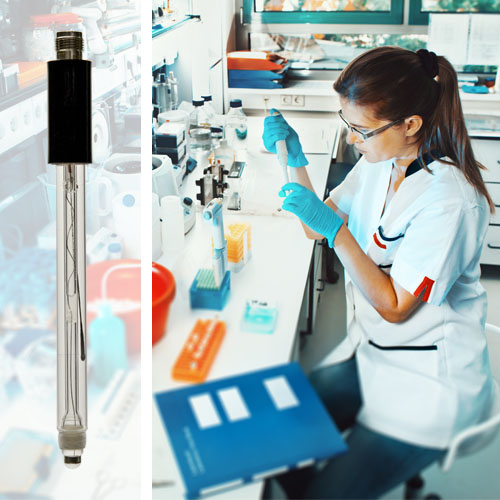AlpHa Measurement Solutions |
Oxidation-Reduction Potential (ORP) in Laboratory
ORP in Laboratory
From R&D and quality control to diagnostic / medical and commercial testing, laboratory applications vary widely in their purpose. In the laboratory, oxidation-reduction potential (ORP or REDOX) measurements are an invaluable tool to understand the condition of the targeted oxidation-reduction reaction.
Depending on the purpose of the laboratory procedure, the analyst can use the ORP measurement to find the best way to influence the reaction to meet the desired result. For example, ORP is a part of a titration procedure to quantify an endpoint or measure the concentration of a targeted substance. Laboratory sensors involve specialized form factors like miniaturization, flow cell apparatus, custom reference electrolytes, or automation. Additionally, reference system designs like refillable and free-flowing junctions are optimal for lab applications.
Depending on the purpose of the laboratory procedure, the analyst can use the ORP measurement to find the best way to influence the reaction to meet the desired result. For example, ORP is a part of a titration procedure to quantify an endpoint or measure the concentration of a targeted substance. Laboratory sensors involve specialized form factors like miniaturization, flow cell apparatus, custom reference electrolytes, or automation. Additionally, reference system designs like refillable and free-flowing junctions are optimal for lab applications.

- Full Range: -1999 to +1999 mV (meter dependent)
- Accuracy: ±0.1 mV (meter dependent)
- Temperature Range: -5 to 135°C
- Warranty: 12 Months
- Form Factor
- 12 mm
- Cartridge
- Process Body
- Custom Options Available
- Housing Material Options
- PVC / CPVC
- Ryton® (PPS)
- ABS
- Epoxy
- Polycarbonate
- Kynar® (PVDF)
- Polyethylene
- PEEK
- Teflon™ (PTFE)
- Ultem® (PEI)
- Glass
- Metal
- Stainless Steel
- Other Metals Available
- Metal
- Thermistor Options
- PT100 (type A & B)
- PT1000
- 10 kohm
- 30 kohm
- 100 kohm
- Any commercially available thermistors and custom options
- Common temperature accuracy is ±0.3°C and can vary based on thermistor option chosen
- Reference System
- Ag / AgCl
- Differential
- Custom Options Available
- Reference Junction Options
- Double Junction
- Single Junction
- Custom Options Available
- Reference Junction Material / Design
- Porous Plastic (PTFE / HDPE / PP)
- Ceramic Pin / Annular / Disc
- Fiber / Pellon
- Sleeve Junction / Free Flow (liquid / liquid or ground glass joint)
- Open Aperture
- Solid State
- Custom Options Available
- Solution Ground
- Integrated in Thermowell
- Integrated in Body Housing
- Stand-alone
- Custom Options Available
- Reference Electrolyte
- Sealed
- Soft Gel
- Solid Gel
- Refillable
- Liquid
- Soft Gel
- Custom Options Available
- Sealed
- ORP Sensor Shape
- Disc
- Single Band
- Double Band
- Pin
- ORP Sensor Material
- Platinum
- Gold
- Silver
- Custom Options Available
- Integrated Insertions
- 3/4" NPT
- 1/2" NPT
- 1" NPT
- PG 13.5
- Custom Options Available
- Analog
- Millivolts
- 4 – 20 mA
- 0 – 5 V
- 0 – 10 V
- Custom Options Available
- Custom options available with preamp capabilities
- Digital
- RS-485 MODBUS RTU
- Custom Options Available
- Connectors
- Integrated Connectors (detachable or cableless)
- S7
- S8
- Integrated BNC
- Variopin
- Custom Options Available
- Connectors with Cables (including temperature)
- BNC
- DIN
- MOLEX
- Mil-spec
- 2.5 mm / 3.5 mm phono
- RCA
- Spade Lugs
- Tinned Leads
- LEMO
- Circular connectors
- Any commercially available connectors and custom options available
- Integrated Connectors (detachable or cableless)

